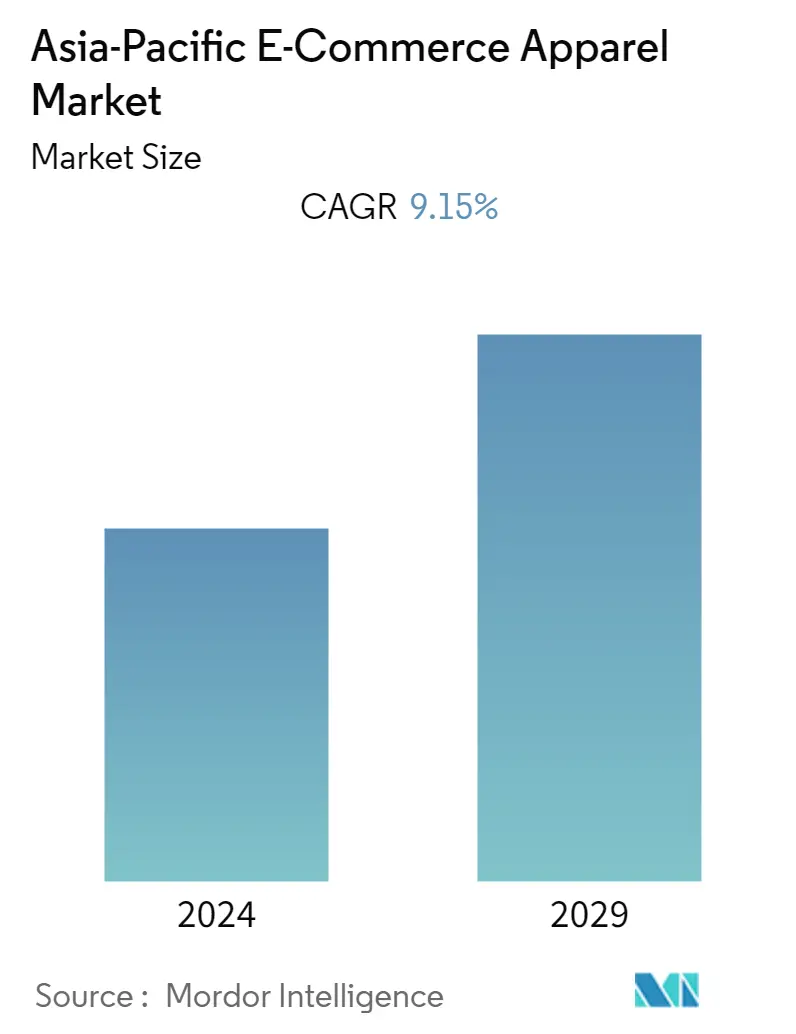Market Size of Asia-Pacific E-Commerce Apparel Industry

| Study Period | 2019 - 2029 |
| Base Year For Estimation | 2023 |
| Forecast Data Period | 2024 - 2029 |
| Historical Data Period | 2019 - 2022 |
| CAGR | 9.15 % |
| Market Concentration | Low |
Major Players
*Disclaimer: Major Players sorted in no particular order |
Asia-Pacific E-Commerce Apparel Market Analysis
The Asia-Pacific e-commerce apparel market was valued at USD 136.94 billion for the current year and is projected to register a CAGR of 9.15% over the next five years.
- The Asia-Pacific region is being recognized as one of the most significant emerging fashion marketplaces and is gaining popularity. Since the West is already saturated, many companies are shifting their focus to emerging regions, likely to boost the growth of the fashion and apparel sectors here. In addition, Asia has experienced a rapid increase in internet accessibility and penetration, which has sparked the region's subsequent digitization. Therefore, the market's growth in terms of value sales has been assisted by the easy accessibility of these apparel through various sales channels, such as internet stores and direct e-commerce companies.
- Additionally, the growing number of fashion advertisements and marketing initiatives, particularly those featured on the covers of publications like Vogue, Cosmopolitan, and Elle, have boosted plus-size women's self-confidence and contributed to the body positivity trend. For instance, in February 2023, D2C and personalized fashion solutions platform CloudTailor in India announced the launch of its Valentine's Day Social Campaign "Love Your Body, Love Your Fit." The company claims that its campaign is dedicated to promoting body positivity and self-love. Hence, these factors act as major market drivers for the body-positive e-commerce clothing sector.
- Moreover, flash sales prices offered by the e-commerce apparel market also drive the Asia-Pacific e-commerce apparel market since the majority of the customers in this region are price sensitive. For example, November 11th, often known as 11/11, is the busiest day of the year for online shopping in China because it is celebrated as Singles Day. Brands usually generate a large portion of their annual revenue through discounts. This kind of event further attracts consumers to shop online, therefore, increasing the number of online consumers that fuel the nation's E-commerce business.
Asia-Pacific E-Commerce Apparel Industry Segmentation
E-Commerce apparel includes the buying and selling of fashion and apparel products online, specifically through e-commerce platforms.
The Asia-Pacific e-commerce apparel market is segmented by product type, end-user, platform type, and geography. Based on product type, the market is segmented into formal wear, casual wear, sportswear, nightwear, and other types. Based on end users, the market is segmented into men, women, and kids/children. Based on platform type, the market is segmented into third-party retailers and the company's own website. The study also covers the analysis of major regions, such as China, Japan, India, Australia, and the Rest of Asia-Pacific.
The market sizing has been done in value terms in USD for all the abovementioned segments.
Asia-Pacific E-Commerce Apparel Market Size Summary
The Asia-Pacific e-commerce apparel market is rapidly emerging as a significant player in the global fashion industry, driven by the region's increasing internet accessibility and digitalization. As Western markets become saturated, companies are shifting their focus to Asia-Pacific, where the demand for fashion and apparel is on the rise. The market's growth is further propelled by the popularity of online sales channels, including internet stores and direct e-commerce platforms, which offer easy access to a wide range of apparel. The region's market dynamics are also influenced by social media strategies and fashion influencers, who are reshaping the industry and driving demand through increased brand visibility and engagement. Events like Singles Day in China highlight the importance of flash sales and discounts, catering to the price-sensitive nature of consumers in the region.
In India, the e-commerce apparel market is experiencing significant growth, supported by initiatives from both private companies and government efforts to democratize online retail. The introduction of platforms like Myntra Minis and digital factory outlets exemplifies the innovative approaches being adopted to attract consumers. The market is characterized by intense competition among major players such as Myntra, Ajio, and Tata Cliq, each striving to capture a larger share of the market. Additionally, the expansion of internet and smartphone usage in India is further boosting the online fashion retail sector. Prominent companies are focusing on product innovation, sustainable practices, and strategic partnerships to enhance their market presence and cater to the evolving consumer preferences in the region.
Asia-Pacific E-Commerce Apparel Market Size - Table of Contents
-
1. MARKET DYNAMICS
-
1.1 Market Drivers
-
1.1.1 Strong Growth of Fashion Marketplaces
-
1.1.2 Increasing Brand Advertisements on Social Media
-
-
1.2 Market Restraints
-
1.2.1 Competition from Traditional Brick-and-Mortar Retail
-
-
1.3 Porter's Five Forces Analysis
-
1.3.1 Bargaining Power of Suppliers
-
1.3.2 Bargaining Power of Buyers/Consumers
-
1.3.3 Threat of New Entrants
-
1.3.4 Threat of Substitute Products
-
1.3.5 Intensity of Competitive Rivalry
-
-
-
2. MARKET SEGMENTATION
-
2.1 Product Type
-
2.1.1 Formal Wear
-
2.1.2 Casual Wear
-
2.1.3 Sportswear
-
2.1.4 Nightwear
-
2.1.5 Other Types
-
-
2.2 End User
-
2.2.1 Men
-
2.2.2 Women
-
2.2.3 Kids/Children
-
-
2.3 Platform Type
-
2.3.1 Third Party Retailer
-
2.3.2 Company's Own Website
-
-
2.4 Geography
-
2.4.1 China
-
2.4.2 Japan
-
2.4.3 India
-
2.4.4 Australia
-
-
Asia-Pacific E-Commerce Apparel Market Size FAQs
What is the current Asia-Pacific E-Commerce Apparel Market size?
The Asia-Pacific E-Commerce Apparel Market is projected to register a CAGR of 9.15% during the forecast period (2024-2029)
Who are the key players in Asia-Pacific E-Commerce Apparel Market?
PVH Corp., Inditex, Hennes & Mauritz AB, Fast Retailing Co., Ltd. and LVMH Moët Hennessy Louis Vuitton are the major companies operating in the Asia-Pacific E-Commerce Apparel Market.

